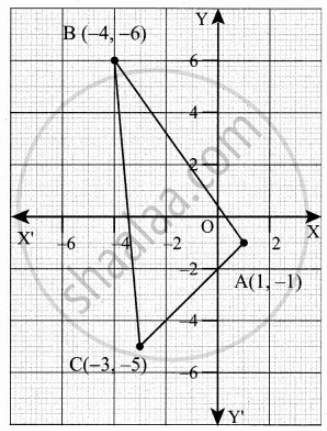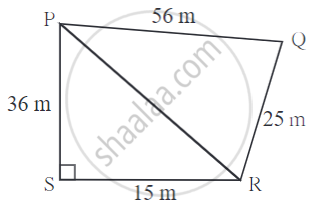Advertisements
Advertisements
Question
Find the area of the triangle formed by the points
(1, – 1), (– 4, 6) and (– 3, – 5)
Solution
Let the vertices A(1, – 1), B(– 4, 6) and C(– 3, – 5)

Area of ∆ABC = `1/2 [(x_1y_2 + x_2y_3 + x_3y_1) - (x_2y_1 + x_3y_2 + x_1y_3)]`
= `1/2[((-4 xx - 5) + (-3 xx - 1) + (1 xx 6)),(-(-3 xx 6) + (1 xx -5) + (- 4 xx - 1))]`
= `1/2[(6 + 20 + 3) - (4 - 18 - 5)]`
= `1/2[29 - (- 19)]`
= `1/2[29 + 19]`
= `1/2 xx 48`
= 24 sq. units
Area of ∆ABC = 24 sq. units
APPEARS IN
RELATED QUESTIONS
A triangle has sides 35 cm, 54 cm and 61 cm long. Find its area. Also, find the smallest of its altitudes ?
Find the area of an isosceles triangle having the base x cm and one side y cm.
Look at the measures shown in the adjacent figure and find the area of ☐ PQRS.

The area of triangle formed by the points (− 5, 0), (0, – 5) and (5, 0) is
The area of a triangle is 5 sq. units. Two of its vertices are (2, 1) and (3, −2). The third vertex is (x, y) where y = x + 3. Find the coordinates of the third vertex.
Find the area of a triangle formed by the lines 3x + y – 2 = 0, 5x + 2y – 3 = 0 and 2x – y – 3 = 0
Using Heron’s formula, find the area of a triangle whose sides are 1.8 m, 8 m, 8.2 m
The sides of the triangular ground are 22 m, 120 m and 122 m. Find the area and cost of levelling the ground at the rate of ₹ 20 per m2
A field in the form of a parallelogram has sides 60 m and 40 m and one of its diagonals is 80 m long. Find the area of the parallelogram.
The sides of a quadrilateral ABCD are 6 cm, 8 cm, 12 cm and 14 cm (taken in order) respectively, and the angle between the first two sides is a right angle. Find its area.
